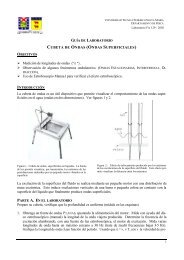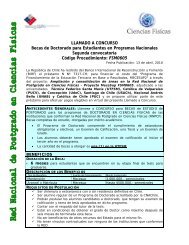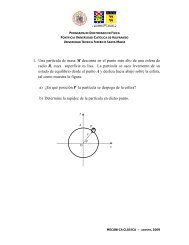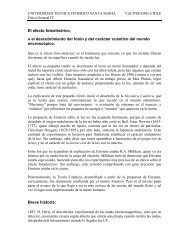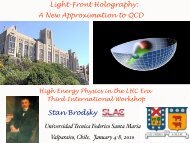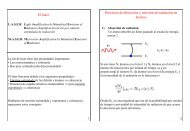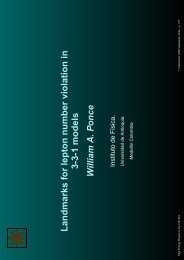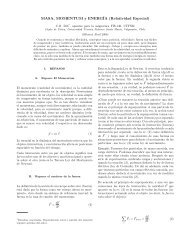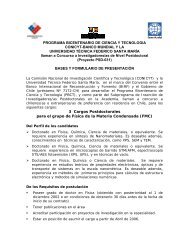Aca - Departamento de Física - Universidad Técnica Federico Santa ...
Aca - Departamento de Física - Universidad Técnica Federico Santa ...
Aca - Departamento de Física - Universidad Técnica Federico Santa ...
Create successful ePaper yourself
Turn your PDF publications into a flip-book with our unique Google optimized e-Paper software.
V Encuentro Sud Americano <strong>de</strong> Colisiones Inelásticas en la Materia<br />
Endohedrally confined atoms in Fullerenes: He (and the time capsule)<br />
Dario Mitnik 1 , Juan Randazzo 2 , Flavio Colavecchia 2 , y Gustavo Gasaneo 3<br />
1 Instituto <strong>de</strong> Astronomía y <strong>Física</strong> <strong>de</strong>l Espacio y Depto. <strong>de</strong> <strong>Física</strong>, <strong>Universidad</strong> <strong>de</strong> Buenos Aires, Argentina<br />
2 Centro Atómico Bariloche, Río Negro, Argentina<br />
3 Depto. <strong>de</strong> <strong>Física</strong>, <strong>Universidad</strong> Nacional <strong>de</strong>l Sur, Bahía Blanca, Argentina<br />
email address corresponding author: dmitnik@df.uba.ar<br />
One of the most fascinating features of<br />
the<br />
fullerene molecules [1] is that they are capable<br />
of<br />
enclosing atoms in their hollow interior,<br />
forming endohedrally confined atoms. Experimental<br />
efforts have ma<strong>de</strong> it possible to<br />
trap atoms insi<strong>de</strong> a fullerene in different<br />
ways. The particular mechanisms responsible<br />
for the insertion of the atom, vary from a<br />
“brute force" implantation, to a “window"<br />
mechanism, in which high temperatures and<br />
pressures can break one of the Carbon-<br />
Carbon bonds in the cage. Small molecules<br />
and atoms can pass through this temporary<br />
hole, forming a stable endohedrally confined<br />
compound.<br />
The properties of a Helium atom confined<br />
insi<strong>de</strong> an endohedral<br />
cavity, like a fullerene, are studied. The<br />
fullerene cavity is mo<strong>de</strong>led by a potential<br />
well and the strength of<br />
this potential is varied in or<strong>de</strong>r to un<strong>de</strong>rstand<br />
the collapse of<br />
different atomic wavefunctions into the<br />
fullerene cage.<br />
Three theoretical calculation methods have<br />
been <strong>de</strong>veloped: a relaxation method, a Sturmian<br />
basis method, and a variational method.<br />
The first two methods are nonperturbative.<br />
The three methods allow inclusion of full<br />
correlations among the two electrons.<br />
Results showing mirror collapse effects are<br />
presented for an<br />
S-wave mo<strong>de</strong>l, in which all the angular quantum<br />
numbers are set to zero. In this work [2] we<br />
showed how the confinement potential<br />
strength<br />
affects in different amounts the atomic levels<br />
of the confined atom.<br />
Figure 1. First three wavefunctions, 1s2 1S, 1sy1 1S,<br />
and 1sy1 3S for different potential <strong>de</strong>pths, around the<br />
first avoi<strong>de</strong>d crossing at U0=1,185 a.u..<br />
Around the regions <strong>de</strong>noted as crossings, it<br />
seems that the variation in the potential produces<br />
<strong>de</strong>generacies in energy,<br />
indicating that the levels can cross each to the<br />
other.<br />
A <strong>de</strong>tailed analysis that requires a very high<br />
<strong>de</strong>gree of precision<br />
shows that the energy levels do not cross<br />
each other,<br />
but rather come close and repel each other<br />
yielding to<br />
an avoi<strong>de</strong>d crossing.<br />
We analyzed the behaviour of the avoi<strong>de</strong>d<br />
crossing levels by using<br />
different information entropies, providing an<br />
efficient tool to estimate in a physically<br />
transparent manner the<br />
26 Valparaíso, Chile



